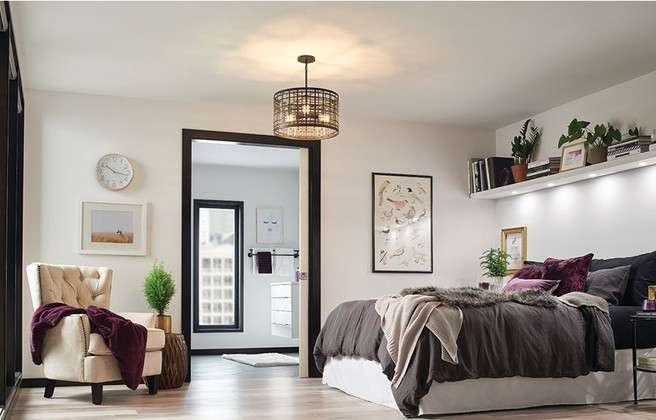LED Spotlight: The Right Way to Light Your Bedroom
Sep 23rd 2020
In some ways lighting your bedroom is no different than lighting other rooms in your home. It all comes down to layered lighting. The way you layer the lighting in your bedroom will of course vary depending upon the size of your room, furniture, and how you intend to use the space. You’ll want to make sure that the lighting you design will complement your space and provide the light you need for how you specifically use your room. The best lighting gives you the light you need at the right levels exactly where you want it so you can use your space the way that best suits you. The worst lighting makes you change your habits to work around the lighting. That’s what we’re trying to avoid.
Whether your style leans more traditional or more modern, there are a few things to keep in mind as you design your bedroom lighting. We’ll talk in broad strokes about some general concepts and then dive into some of our favorite bedroom lighting trends.
Ambient lighting
There are many ways to create ambient lighting in your bedroom. Common fixtures are ceiling fans, recessed cans, lamps, and ceiling fixtures. Ambient light should be a balance between natural and artificial light. This is the light you’ll use most often when walking into the room to find something, fold laundry, make the bed, etc. Ceiling fixtures, whether flush mounted or recessed are good options for ambient lighting. The main thing to consider is balance. Having too much overhead lighting and not balancing it out with anything else will do a disservice to your room and even to the way you appear in the mirror.
Task lighting
Task lighting in the bedroom is fairly straightforward. Task lighting was typically about having reading lights near the bed or light for applying or removing makeup. Now with more people working from home and, more specifically, from the comfort of their own beds and bedrooms, the need for good task lighting has expanded as well. Whether you’ve set up a desk in your bedroom or simply work sitting in bed with a laptop tray table setup, your new “office” workspace requires more light than what typically would have passed for bedside task lighting. Consider how much time you spend in your room, what tasks you perform there, and light according with bedside lamps, swing arm sconces, and other smaller movable lights that can move with you as you adjust your positions throughout your room.
Decorative / accent lighting
If there’s one room where decorative and accent lighting is often overlooked, it’s the bedroom. Mostly, that’s okay - it’s not a room commonly used for entertaining. However, there are some good reasons to round out your layers with decorative and accent lighting in your bedroom. Decorative lighting in the bedroom can add to the ambient light in the room while also providing softer mood lighting or another interesting focal point. This is also another way to show off some of your personal style by selecting a beautiful, unique, or decorative light that simply brings joy to look at in your room.
Modern bedroom lighting trends
As we’ve seen in previous articles, chandeliers are making a big comeback in bedrooms. From big, traditional, and ostentatious to small, sleek, and modern, chandeliers are a great way to provide lots of ambient light while making a statement at the same time.
If chandeliers aren’t really your style, consider pendant lights for your bedroom. The position of the lights themselves may vary depending upon your preference. We recommend using pendants as stand-ins for bedside lamps especially for smaller rooms where space is limited and there may not be room enough on nightstands for the other items you want to keep close to hand in your room. Positioning pendants at about the height of a floor or table lamp’s bulb will provide nice, ambient / decorative light but may not be quite as useful as task lighting as a more purpose-designed reading light.
In general there are some big dos and don’ts for modern bedroom lighting. We alluded to one a bit earlier on: recessed and overhead lighting. The biggest thing here is don’t overdo it. You don’t want too much overhead light. Some recessed lighting is always a good option for a bedroom, but relying solely or too much on it can cause some very stark and unflattering lighting.
Do consider using fewer, larger fixtures for a bigger impact. Smaller, standardized fixtures seem to lay flat and disappear into the room. Using something that has presence will help tie the room together. Keep in mind that symmetry isn’t really important when it comes to bedroom lighting. The biggest thing is striking a balance so the room is well lit, shadows are eliminated, and dark corners are brightened up. You may also consider some source of indirect lighting - light bouncing off something - whether sconces that throw light back on the wall, cove lighting that grazes the ceiling or an architectural feature, or picture lights or spots for artwork. The goal is to bring your eye around the entire room, not just to focus on the bed. Bringing light to different corners makes a space feel bigger and balanced. The goal isn’t an evenly lit room, but an interestingly lit one, so your eye travels from fixture to fixture.
For more ideas about how to light your home, check out our article on the hottest lighting trends for the 2020s. And click here for SunLake’s full LED product catalog.


